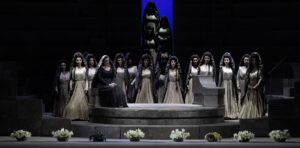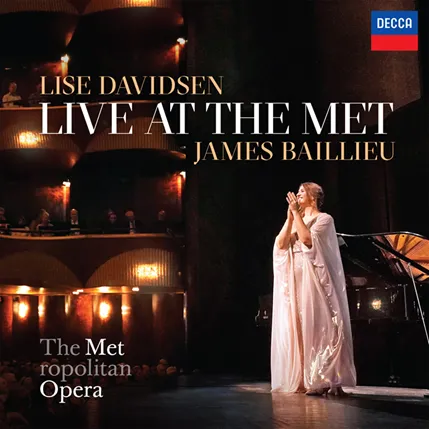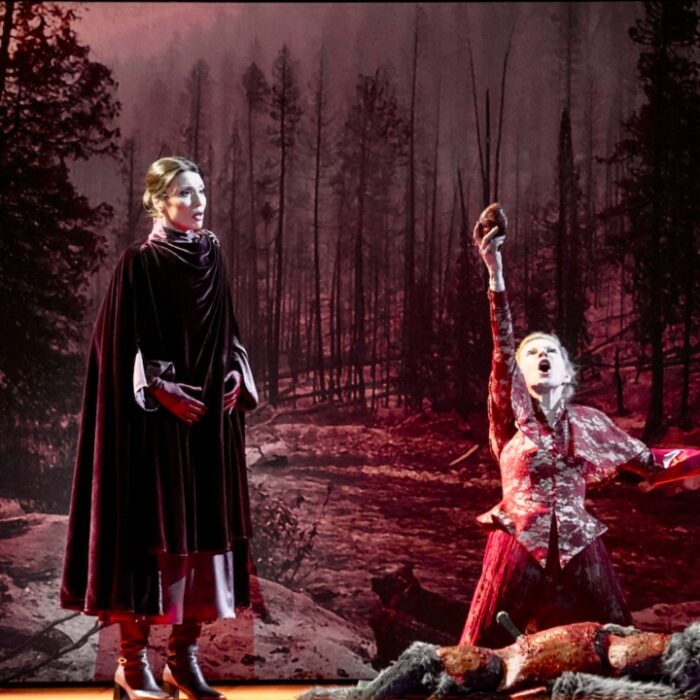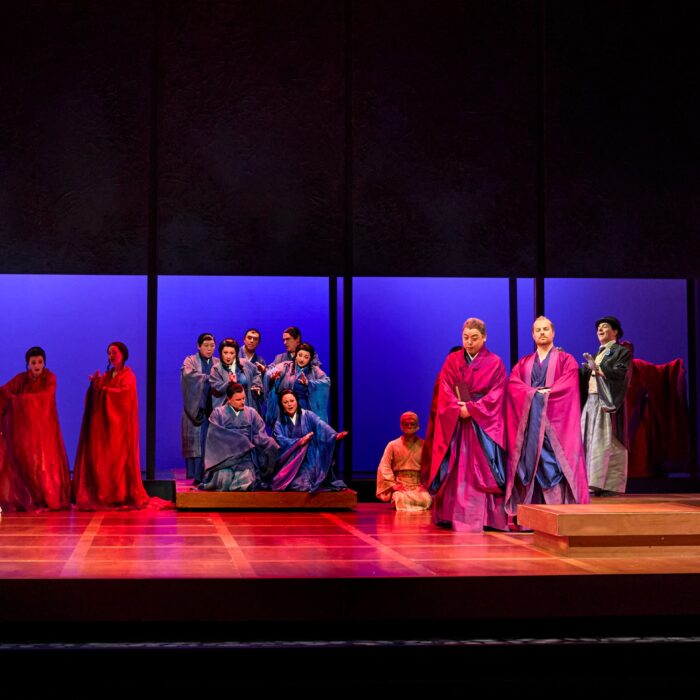
Teatro Lirico di Cagliari 2023 Review: Gloria
Cilluffo & Albanese Make Excellent Case For Cilea’s Final Opera
By Alan NeilsonCredit: Priamo Tolu
The Sardinian landscape is dotted with archeological monuments, burial sites, towers, and dwellings built by the various peoples that long ago settled the island. The Beakers, Nuraghe, Phoenicians, and Romans, to name but a few, have all left their mark. The island’s museums boast impressive collections of artifacts fashioned in metal, glass, stone, and clay that reflect various aspects of these past civilizations. There are statues of their gods and rulers as well as small statuettes of their ships and animals, of their people clothed in their traditional costumes, and their warriors brandishing weapons. There are examples of their jewelry, masks, and tombs. Walking around its principal city, Cagliari, the visitor will come across many sites from antiquity, including the Roman amphitheater, carved from the rock 1800 years ago, which seated 10,000 people. It is a history that inhabits the present in a physical sense, making the past almost impossible to avoid.
Albanese’s Inventive and Convincing Staging
This is the background for theatre director Antonio Albanese’s presentation for the Teatro Lirica di Cagliari’s production of Francesco Cilea’s final three-act opera, “Gloria.” Written in 1907 to a libretto by Arturo Colautti, the opera was premiered at La Scala under the baton of Toscanini but failed to establish itself, as did its 1932 shortened revision aided by librettist Ettore Moschini. The plot is a straightforward affair with much in common with Romeo and Juliette, in which two childhood sweethearts later in life find themselves on opposite sides of a conflict and eventually die as a result of positioning love above family loyalty.
Albanese has a history of relating his productions to the area in which the theatre is located, although not by creating a realistic visual representation, but by capturing its “unique atmosphere.” This may sound contrived and heavy-handed, especially when dealing with an opera such as this, which is set in medieval Siena at the time of the Guelph-Ghibelline conflict. It proved, however, to be nothing of the sort; the marriage of a Sardinian context with the opera’s narrative actually had a liberating effect, allowing the drama to flourish outside its narrow historical context. Moreover, certain parallels between ancient Sardinia and medieval Siena were brought to the fore, which had the effect of enhancing the force of the libretto, most notably in its treatment of water. In Act one, Gloria sings of the fountain in the central piazza as a symbol of peace, a theme that is then taken up by the chorus. This becomes a far more potent scene in the Sardinian context, as during the Bronze Age, there was a cult of water to which the people dedicated holy wells.
The scenographer Leila Fteita created a movable, raked standing area for the chorus, which was altered slightly for each of the three acts. Its similarity to the city’s Roman amphitheater was immediately clear and worked well in focusing the drama. The chorus was positioned on its two sides, with the central area left free for the fountain in Act one, a small, raised stone area in Act two, and a marriage altar in Act three. It was also used as the main performance area for the principal singers.
The costumes designed by Carola Fenocchio were based on traditional dress from various eras of Sardinia’s pre-Christian past, although they were certainly not exact reproductions. Rather, they were futuristic versions drawn from the imagination, which allowed the drama to operate outside a specific time period. Generally, the colors were calm and sedate, with Gloria costumed in a blood-red dress in the final act, which created a powerful contrast and successfully highlighted her central role.
Along with Andrea Ledda’s sensitive lighting, the creative team successfully developed a well-balanced, aesthetically pleasing staging with classical proportions that evoked impressions of ancient Rome.
In his program notes, Albanese stated he wanted to create a staging that was not tied to any specific time or place, yet drew upon the “unique atmosphere” that defines Sardinia. This is exactly what he achieved, and it worked splendidly. The reading was faithful to the music in developing the emotional content of the drama and improved on the libretto by promoting the narrative within a universal context, ensuring that its simple themes were not obscured or overshadowed by the medieval pageantry of 14th-century Siena.
Cilluffo’s Compelling Musical Direction
The musical side of the production was under the direction of Francesco Cilluffo, who produced a very impressive reading from the Orchestra del Teatro Lirica. Cilea’s score possesses a big sound and explosive crescendos and is orchestrated for a large orchestra using an imaginative array of instruments. Cilluffo held it all together convincingly over the course of each act, driving it forward with energy and clarity, successfully shaping it to highlight the significant dramatic points yet without compromising its rich melodic fabric. It is not, however, a one-paced score, and often the music calms, allowing delicate, lightly orchestrated passages to take over. Cilluffo managed the contrasts perfectly so that not only was the musical coherence retained, with the individual instruments emerging seamlessly from the orchestra as its heavy sound subsided, but he also ensured that they conveyed the easing dramatic tensions. It was a reading that successfully brought out the score’s beautiful coloring and fascinating contrasting textures.
Cilluffo also displayed acute sensitivity in managing the balance between the stage and the pit. The singers were provided with strong support throughout, and the powerful orchestral sound and the strength of the chorus were rarely allowed to overwhelm the soloists, yet the sense of freedom with which the orchestra played or with which the singers engaged with their roles was never compromised.
Singers Produce Committed and Engaging Performances
Anastasia Bartoli was down to play the demanding role of Gloria, but had to withdraw at the last moment due to an illness. She was replaced by soprano Valentina Boi, who was playing the part in the second cast. She gave an inconsistent performance, which initially appeared to be because of a little nervousness. Her voice sounded insecure in the opening scene, although it quickly settled, and her confidence quickly asserted itself. However, small problems continued to litter her performance: her vibrato was a little heavy at times, her lines often sounded clipped, and her failure to hit the top C, which brings Act two to an end, left a negative impression that grew throughout the interval. Nevertheless, there were also plenty of positives. She possesses a colorful and flexible voice, able to switch successfully between passages of sweet delicacy and more strident, commanding sections, which allowed her to envelop the vocal line with emotional strength and develop characterization. Hers is a resonant voice, which she used confidently to engage in high-octane duets with Lionetto, which added to the dramatic frisson as they both competed with the orchestra. It was an expressive performance, one in which she thoroughly engaged.
The tenor Carlo Ventre was parted as Lionetto. It is a heroic role requiring a secure, resonant, and energetic voice, and Ventre did not disappoint. His ability to project his voice to fill the auditorium or to send it soaring over the orchestra was dramatically compelling and aurally impressive. He injected every line with strong emotion; his singing was secure and expansive, and his delivery of duets was forceful and energetic. It is a testament to the quality of the other singers that they were able to hold their ground when singing alongside him. He was a hero par excellence! However, it was not the most subtle of portraits, and, on occasions, he did not adjust the voice sufficiently to meet the dramatic situation: when he lay dying, his voice was still ringing out loudly.
Baritone Franco Vassallo produced a compelling performance in the role of Folco de’Bardi, a man bent on violence, revenge, and war. He possesses a secure, powerful, versatile voice with a palette of dark, rich colors, which he used intelligently to deliver well-crafted, expressive phrases in what was the most well-rounded performance of the evening. He was hot-tempered, impulsive, and vicious. Moreover, with his swarthy looks and long, black, unkempt hair, he looked the part, too. His confrontation with his sister Gloria was particularly convincing as it brought out the depth and complexity of the emotions when siblings quarrel.
Bass Ramaz Chikviladze, in the relatively small role of Aquilante de’Bardi, produced a suitably authoritative performance that showed off his resonant and pleasing bass to good effect.
Soprano Elena Schirru parted as a Sienese woman, made a strong impression in her brief appearance at the start of Act two, in which her singing grabbed the attention with its clear articulation, strength, pleasing timbre, and well-crafted phrasing.
The cast was completed by bass Alessandro Abis as the Bishop who presided over the wedding ceremony and Alessandro Frabotta, also a bass, as a bandit. Both produced solid performances.
The Coro del Teatro Lirico, under the direction of Giovanni Andreoli, gave a strong performance, filling the auditorium with Cilea’s beautiful melodies that lay easily on the ear.
Overall, this was a thoroughly absorbing performance, one that surely vindicates Cilea’s belief in the opera’s quality. He sent the score to Caruso and, later, to Callas, but neither showed interest, which begs the question, why has “Gloria” been so neglected? Certainly, the music cannot be the reason; it is inventive, accessible, and certainly not particularly backward-looking. Possibly, it is because its structure and plot were considered old-fashioned by the early 20th century. Its simple theme of love versus family loyalty was typical of the 19th century: one could imagine a young Verdi writing an opera based on this libretto. Also, its simple musical structure, based around a succession of musical numbers consisting of arias, duets, and choruses, was no longer in fashion.
Ninety years on, does it matter that it was not in fashion at the time of its premiere? Surely, if the work has the quality to attract, entertain, and interest audiences, it deserves to be performed.



